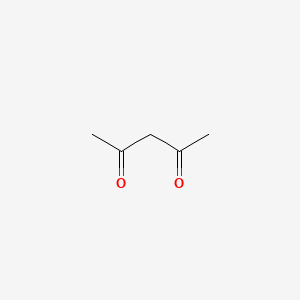| MeSH term | MeSH ID | Detail |
|---|---|---|
| Adenocarcinoma | D000230 | 166 associated lipids |
| Body Weight | D001835 | 333 associated lipids |
| Dermatitis, Contact | D003877 | 59 associated lipids |
| Eczema | D004485 | 4 associated lipids |
| Edema | D004487 | 152 associated lipids |
| Fetal Resorption | D005327 | 15 associated lipids |
| Glioma | D005910 | 112 associated lipids |
| Nervous System Diseases | D009422 | 37 associated lipids |
| Purpura, Thrombocytopenic | D011696 | 2 associated lipids |
| Seizures | D012640 | 87 associated lipids |
2,4-pentanedione
2,4-pentanedione is a lipid of Fatty Acyls (FA) class. The related lipids are Butyrates.
Cross Reference
Introduction
To understand associated biological information of 2,4-pentanedione, we collected biological information of abnormalities, associated pathways, cellular/molecular locations, biological functions, related genes/proteins, lipids and common seen animal/experimental models with organized paragraphs from literatures.
What diseases are associated with 2,4-pentanedione?
There are no associated biomedical information in the current reference collection.
Possible diseases from mapped MeSH terms on references
We collected disease MeSH terms mapped to the references associated with 2,4-pentanedione
PubChem Associated disorders and diseases
What pathways are associated with 2,4-pentanedione
There are no associated biomedical information in the current reference collection.
PubChem Biomolecular Interactions and Pathways
Link to PubChem Biomolecular Interactions and PathwaysWhat cellular locations are associated with 2,4-pentanedione?
There are no associated biomedical information in the current reference collection.
What functions are associated with 2,4-pentanedione?
There are no associated biomedical information in the current reference collection.
What lipids are associated with 2,4-pentanedione?
Related references are published most in these journals:
| Lipid concept | Cross reference | Weighted score | Related literatures |
|---|
What genes are associated with 2,4-pentanedione?
There are no associated biomedical information in the current reference collection.
What common seen animal models are associated with 2,4-pentanedione?
There are no associated biomedical information in the current reference collection.
NCBI Entrez Crosslinks
All references with 2,4-pentanedione
Download all related citations| Authors | Title | Published | Journal | PubMed Link |
|---|---|---|---|---|
| Oh YK | Acid-base disorders in ICU patients. | 2010 | Electrolyte Blood Press | pmid:21468199 |
| Salthammer T et al. | Formaldehyde in the indoor environment. | 2010 | Chem. Rev. | pmid:20067232 |
| Coen PM et al. | Insulin resistance is associated with higher intramyocellular triglycerides in type I but not type II myocytes concomitant with higher ceramide content. | 2010 | Diabetes | pmid:19833891 |
| Athanasellis G et al. | Tetramic and tetronic acids as scaffolds in bioinorganic and bioorganic chemistry. | 2010 | Bioinorg Chem Appl | pmid:20508811 |
| Wu TY et al. | Synthesis and characterization of organic dyes containing various donors and acceptors. | 2010 | Int J Mol Sci | pmid:20162019 |
| Hanson-Smith V et al. | Robustness of ancestral sequence reconstruction to phylogenetic uncertainty. | 2010 | Mol. Biol. Evol. | pmid:20368266 |
| Schlafer S et al. | Filifactor alocis--involvement in periodontal biofilms. | 2010 | BMC Microbiol. | pmid:20193074 |
| Diebold AR et al. | The three-his triad in Dke1: comparisons to the classical facial triad. | 2010 | Biochemistry | pmid:20695531 |
| Alagona G et al. | The catalytic effect of water on the keto-enol tautomerism. Pyruvate and acetylacetone: a computational challenge. | 2010 | Phys Chem Chem Phys | pmid:20676455 |
| Ghanti E and Nagarajan R | Synthesis of CuAl2(acac)4(O(i)Pr)4, its hydrolysis and formation of bulk CuAl2O4 from the hydrolyzed gels; a case study of molecules to materials. | 2010 | Dalton Trans | pmid:20571649 |
